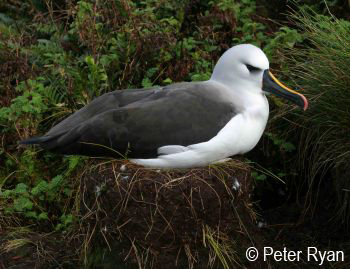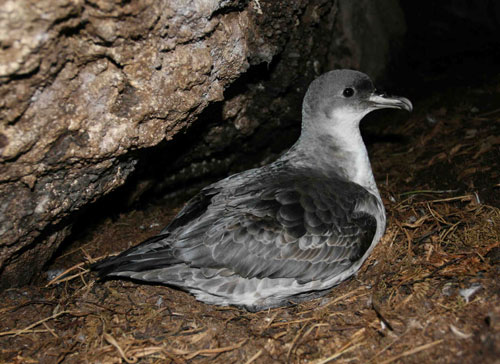South African research on ACAP-listed species is primarily carried out at two island groups, South Africa's Prince Edward Islands in the southern Indian Ocean and the United Kingdom's Tristan da Cunha Group in the South Atlantic. At the former research activities are concentrated on Marion Island, at the latter on Gough and Inaccessible Islands, in conjunction with partners at the UK's Royal Society for the Protection of Birds (RSPB) and Tristan's Conservation Department (TCD). Research is also carried out on ACAP species at sea, both off South Africa and in the Southern Ocean south of the continent.
There are two main research centres, the FitzPatrick Institute of African Ornithology at the University of Cape Town, and the Marine and Coastal Development Branch of the Department of Environmental Affairs. The former body concentrates on conducting research and teaching post-graduate students, whereas the latter fulfils South Africa's commitments to both ACAP and CCAMLR by conducting annual monitoring of seabirds at Marion Island.

A total of five long-term demographic studies is being conducted on ACAP-listed species, with a sixth (on Southern Giant Petrels Macronectes giganteus on Gough Island) set to start in 2010. The established studies are on Wandering Diomedea exulans and Grey-headed Thalassarche chrysostoma Albatrosses and Northern Giant Petrels M. halli at Marion Island, and Tristan D. dabbenena and Atlantic Yellow-nosed T. chlororhynchos Albatrosses at Gough. The oldest of these studies, on Marion's Wanderers, has now been running for three decades.
Research on ACAP-listed burrowing petrels includes recent censuses of White-chinned Petrels Procellaria aequinoctialis at the Prince Edwards and of Spectacled Petrels P. conspicillata at Inaccessible. Genetics work has also been carried out on these two petrels, confirming their specific status.
A limited amount of work is being conducted on winter-breeding Grey Petrels P. cinerea at Marion (where they are rare) and at Gough (where they may be at risk to introduced mice).

Research on ACAP-listed species at Marion Island has also been undertaken by the Animal Demography Unit, Department of Zoology at the University of Cape Town, most recently on the effects of human disturbance (click here).
South African scientific and popular publications on ACAP-listed species in 2009
Angel, A, Wanless, R.M. & Cooper, J. 2009. Review of impacts of the introduced House Mouse on islands in the Southern Ocean: are mice equivalent to rats? Biological Invasions 11: 1743-1754.
Cooper, J. 2009. Foreword. In: James, N. Allie makes a Difference. Wynberg: Don Nelson. p. 8.
Cooper, J., Bester, M.N., Chown, S.L., Crawford, R.J.M., Daly, R., Heyns, E., Lamont, T., Ryan, P.G. & Shaw, J.D. 2009. Biological survey of the Prince Edward Islands, December 2008. South African Journal of Science 105: 317-320.
Cooper, J., Cuthbert, R. & Glass, T. 2009. Plight of the albatross. Tristan da Cunha Newsletter 44: 24-25.
Cooper, J., Morgan, K.H. & Tasker, M.L. 2009. Listing North Pacific albatrosses within the Agreement on the Conservation of Albatrosses and Petrels. Marine Ornithology 37.
Jones, M.G.W. & Ryan, P.G. 2009. Evidence of mouse attacks on albatross chicks on sub-Antarctic Marion Island. Antarctic Science doi:10.1017/S0954102009990459.
Oosthuizen, W.C., Dyer, B.M. & de Bruyn, P.J.N. 2009. Vagrant birds ashore at the Prince Edward Islands, southern Indian Ocean, from 1987 to 2009. African Journal of Marine Science 31: 445-450.
Petersen. SL., Honig, M.B., Ryan, P.G. & Underhill, L.G. 2009. Seabird bycatch in the pelagic longline fishery off southern Africa. African Journal of Marine Science. 31: 191-204.
Petersen, S.L., Honig, M.B., Ryan, P.G., Underhill, L.G. & Goren, M. 2009. Seabird bycatch in the demersal longline fishery off southern Africa. African Journal of Marine Science. 31: 205-214.
Ryan, P.[G.] 2009. The seabirds of the Conrad Rise, Southern Ocean. Bulletin of the African Bird Club 16: 67-77.
Ryan, P.G. 2009. The world of birds: sixth albatross species breeding on Prince Edward Island. Africa Birds & Birding 14(2): 14.
Ryan, P.G. 2009. Seabird conservation: sign of the times for Tristan Albatrosses. Africa Birds & Birding 14: 12.
Ryan, P.G., Jones, M.G.W., Dyer, B.M., L Upfold, L. & Crawford, R.J.M. 2009. Recent population estimates and trends in numbers of albatrosses and giant petrels breeding at the sub-Antarctic Prince Edward Islands African Journal of Marine Science 31: 409-417.
Techow, N.M.S.M.. O'Ryan, C., Phillips, R.A., Gales, R., Marin, M., Patterson-Fraser, D., Quintana, F., Ritz, M.S., Thompson, D.R., Wanless, R.M., Weimerskirch, H. & Ryan P.G. 2009. Speciation and phylogeography of giant petrels Macronectes. Molecular Phylogenetics and Evolution doi:10.1016/j.ympev.2009.09.005.
Techow, N.M.S.M., Ryan, P.G. & O'Ryan, C. 2009. Phylogeography and taxonomy of White-chinned and Spectacled Petrels. Molecular Phylogenetics and Evolution 52: 25-33.
Visser, P., Louw, H., Cuthbert, R. & Ryan, P.[G.] 2009. Salvin's Albatross Thalassarche salvini on Gough Island, South Atlantic. Bulletin of the African Bird Club 16: 215-216.
Wanless, R.[M.] 2009. BirdLife's Albatross Task Force - incentives to reduce seabird bycatch in South African Fisheries. Bycatch Communication Network Newsletter 12: 2-3.
Wanless, R.M., Ryan, P.G., Altwegg, R., Angel, A., Cooper, J., Cuthbert, R. & Hilton, G.M. 2009. From both sides: dire demographic consequences of carnivorous mice and longlining for the critical endangered Tristan Albatrosses on Gough Island. Biological Conservation 142: 1710-1718.
Wheeler, M., de Villiers, M.S. & Majiedt, P.A. 2009. The effect of frequency and nature of pedestrian approaches on the behaviour of Wandering Albatrosses at sub-Antarctic Marion Island. Polar Biology 32: 197-205.
For earlier publications on ACAP-listed species by the FitzPatrick Institute go to http://www.fitzpatrick.uct.ac.za/docs/publist.html.
John Cooper, ACAP Information Officer, Rob Crawford, Marine and Coastal Management, Department of Environmental Affairs and Peter Ryan, FitzPatrick Institute, University of Cape Town, 7 January 2010

 English
English  Français
Français  Español
Español